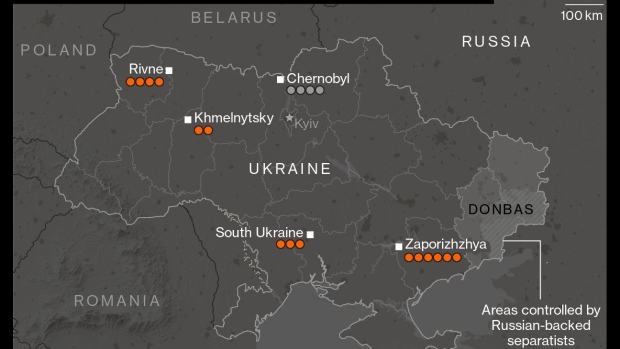Aug 8, 2022
Russia Invites Nuclear Monitors to Visit Shelled Ukrainian Plant
, Bloomberg News

(Bloomberg) -- Russia told diplomats it’s ready to welcome international monitors into Ukraine’s Zaporizhzhia nuclear power plant, whose safety is in doubt after coming under attack last week.
International Atomic Energy Agency inspectors have said there’s a “very real risk of a nuclear disaster” at Europe’s biggest atomic power plant amid fighting in the area. The Zaporizhzhia site, with six reactors worth tens of billions of dollars, has been occupied by Russian forces since March.
The Kremlin’s envoy to the IAEA has invited an international mission to Zaporizhzhia to conduct “activities within the framework of the implementation of safeguards, as well as monitoring the state of nuclear safety and security,” according to a note circulated among diplomats in Vienna.
The Russian move is just one of a series of steps required for the IAEA to send inspectors. Speaking at the United Nations last week, IAEA Director-General Rafael Mariano Grossi said he needs permission from Ukraine’s government, as well as security guarantees and a safe passage through the war zone.
“Going there is a very complex thing because it requires the cooperation and understanding of a number of actors,” Grossi said. “It’s a Ukrainian facility, so it requires Ukraine to agree. At the same time, the plant is occupied by Russia and I have to talk to everybody.”
Ukraine’s nuclear utility, Energoatom, appeared to back the suggestion for an international mission to Zaporizhzhia on Monday.
“We call on our partners to make a demilitarized zone at the station,” Energoatom President Petro Kotin said in a broadcast interview. “There should be a mission of peacekeepers and experts from the IAEA and other organizations.”
Ukraine believes there to be about 500 Russian soldiers in and around the Zaporizhzhia site, which continues to be operated by Ukrainian technicians. The shelling damaged cables at a nearby coal-power plant, which provides electricity for cooling and circulation at the nuclear site, according to regulators.
Without constant electricity flows to moderate atomic fission, nuclear reactors run the risk of melting down. Ukraine’s Chernobyl disaster in 1986 spread radiation over a wide swath of Europe. The fallout from Japan’s Fukushima meltdown in 2011 continues, with plants still being cooled and Tokyo’s government making plans to pump irradiated material out to sea.
©2022 Bloomberg L.P.








